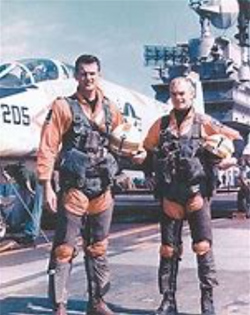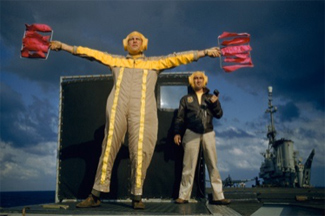You can’t imagine how large an aircraft carrier is until you stand next to it on the pier. This thousand foot long stretch of gray steel blots out everything. From the water line to the top of the masts is four hundred feet. 5,500 sailors and officers live aboard her.
Shortly after boarding the ship operations commence. Our training class is issued flight suits. The first step takes place in the pilots’ ready room. Each of us is assigned a pilot who’ll fly our plane.
 Mine is a short, husky, sandy haired Irishman named Terence. He’s all energy and confidence. He slaps me on the back and says, “Johnny my lad, we’re goin’ to have some fun today.” I get an anxious feeling. I’m wondering, how much fun and for whom?
Mine is a short, husky, sandy haired Irishman named Terence. He’s all energy and confidence. He slaps me on the back and says, “Johnny my lad, we’re goin’ to have some fun today.” I get an anxious feeling. I’m wondering, how much fun and for whom?
The aircraft are two seat, T1A jet trainers. In the ready room it’s clear we’re novices who should keep our mouths shut—our eyes and ears open. We’re about to participate in the launch and recovery of our aircraft on a carrier that’s traveling 20 to 30 knots (23 to 35 mph) into a headwind and plunging as much as 35 feet up and down in the sea. This isn’t a child’s game.
The pilots are highly trained professionals—deadly serious. Once we’ve picked up our equipment: helmet, oxygen mask, life vest, G-suit and gloves we follow our pilots to the flight deck. As we step onto the deck we’re hit with overwhelming noise and wind.
A large number of men in colored shirts with helmets seem to run around aimlessly. Yet, within a minute I can see that each has a well-choreographed role:

– Red shirts: handle weapons and ammunition
– Purple: fuel the aircraft
– White: focus on safety, final inspections of aircraft prior to launch
– Blue: position aircraft on the flight deck
– Yellow: direct movement of aircraft
– Green: hook planes to the catapults and handle arresting cables
– Silver: deal with crashes and/or fires
– Brown: is the plane captain assigned to each individual aircraft
With as many as 140 of these men moving rapidly about the deck, it’s obvious this must be perfectly timed. Mistakes can result in aircraft damage or loss of life. What’s scary is the average age of the flight deck crew is only 19. A year ago they were attending their high school prom. Now they’re responsible for millions of dollars and hundreds of lives. I climb into the front seat of my plane helped by the plane captain while the pilot, Terence of the big mischievous smile, takes the back seat. My job is to listen through my headset and keep my hands off everything.
There are two parallel catapults alternatively launching aircraft over the bow, two hundred feet above the sea. Every 25 to 30 seconds one of them is thrown forward at about 165 miles per hour. I’m told to keep my head against the headrest because the acceleration will snap it back there anyway. When we’re set a yellow shirt gives a signal, and we go. The catapult throws us clear of the bow and we head out at an altitude no higher than 500 feet. Incoming aircraft have altitudes above 500 feet for their return to the carrier.
Several miles out Terence pulls back on the stick and we climb rapidly to 30,000 feet. We form up on the wing of the flight leader’s plane and head to a designated area where we carry out our flight plan. I’ve been at 30,000 feet on a commercial airliner, but this is an entirely different sensation. It’s like sitting on a surf board and looking at infinity in all directions; scary, but exhilarating. For the next hour Terence explains various maneuvers we’re making. For fun he abruptly pulls up, rolls right and dives a few thousand feet just to see if I can retain my breakfast. Finally, he tells me to take the control stick and fly the plane. The stick is pretty simple, but coordinating that with the throttle, flaps, ailerons and rudder is not easy. We make a few stomach churning moves before I turn the control back to Terence. The rest of the exercise takes us back to the ship for what they call recovery. Here’s where the problem starts.
The ship had been headed northeast originally, roughly toward Bermuda. To launch and recover aircraft we have to run into the wind, which has shifted and now is blowing out of the southeast. A storm front over central Atlantic is moving faster than predicted. The captain can’t turn the ship and run away because it’s generating the winds we need to recover our aircraft. High speed jet aircraft can’t land on a carrier safely with a tailwind. The only alternative is to head directly toward the front and bring the planes in as fast as possible. Then, he can bring the ship about and run from the storm.
Landing a twenty thousand pound aircraft traveling at about 175 knots onto a flight deck that is moving away at 20 to 30 knots, and maybe heaving up and down as much as 35 feet isn’t child’s play under optimum conditions. Rough air and poor visibility make it very dicey. We have to hit a spot on the deck that is about the size of half a tennis court. Plus, we’re approaching at a fourteen degree angle to the path of the ship because of the canted flight deck. It means the pilot is “slipping” the plane slightly as he tries to line it up on his landing target that is sliding away from him.
As we near the carrier we hit a rain squall and the visibility drops; not good. We move into line to land by flying downwind along the left or port side of the ship. The planes are spaced 45 seconds apart. As we turn onto the base leg running at a right angle to the ship the rain stops. We bank onto the final leg headed for our landing target. There’s heavy mist cutting visibility in half. Either we hit our spot or we go around and try again. Even if we land on the spot our hook may bounce and miss the three arresting cables that stop an incoming aircraft. These cables stop this 175 mph, 20,000 pound plane in just two seconds when the hook catches one of the three. Having to make a second pass is bad. It messes up the process and the pilot has to have a talk later with the LSO (landing signal officer) who directs the recovery.
 Every landing is graded green, yellow or brown. Brown means you failed and your future as a carrier qualified pilot is in jeopardy.
Every landing is graded green, yellow or brown. Brown means you failed and your future as a carrier qualified pilot is in jeopardy.
As we approach the vicinity of the ship we’re fifth in line. That means 5 times 45 seconds, or about four minutes of white knuckle flying. Being in the front seat, if we make a bad landing I’m going to be the first thing that slams into the deck, takes a dip into the Atlantic or crashes into the stern of the ship. There’s nothing I can do but watch and wait. In the end we make a good landing. But our hook breaks. We accelerate to go around for another pass. The problem is that without a workable hook we have only two alternatives. One is to bail out and ditch ourselves and the million dollar plane in the cold sea. If I have a vote I will vote for number two, which is to land and be caught in the barricade. Number two is everyone else’s choice as well.
The barricade, called arresting gear, is an emergency recovery system used only when the normal arrestment cannot be made. To rig the 88 foot wide barricade, it’s upper and lower horizontal straps are stretched across the flight deck between stanchions, raised above the surface. Vertical straps, about five feet apart, are connected to horizontal load cables. The barricade is raised to a height of approximately 20 feet. The webbing is to engage the wings of the landing aircraft and pull it to a stop. This makes a mess of the flight deck so the process calls for landing all other planes first and then the wounded duck comes in.
After fifteen minutes of high anxiety we come around for the final leg as the barricade is in place. I have the front row seat of the system in operation. It’s both frightening and comforting. When we slam into the deck Terence cuts the engine. We’re wrapped up in the barricade straps and dragged to a halt. The deck crew pulls us out of the plane and I walk unsteadily across the flight deck and down to the ready room for debriefing.
I’m thinking maybe it wasn’t so bad that I couldn’t pass the eye test and become a naval aviator, if this is what it means.


Recent Comments